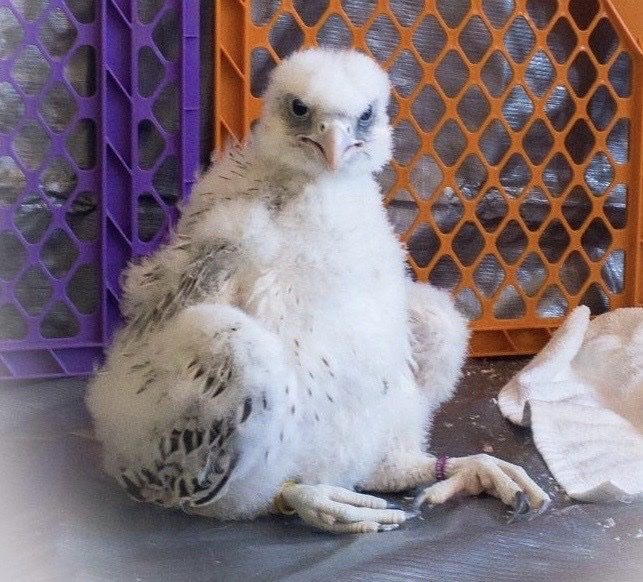The U.S. Air Force Academy added a new mascot to its Falconry Team.
“Losing Aurora last fall was very difficult for us. We are deeply committed to our birds and look forward to raising the new mascot and sharing her with the world!” Falconry Officer In Charge Col. Jennifer Alexander said in a statement shared with Air Force Magazine.
Aurora, a rare white gyrfalcon, died in October 2019 at the age of 23—roughly twice the age Falcons typically live in the wild, the Academy said at the time. She was injured about a year before her death when she and another falcon were taken as part of a rival football prank, making national news.
The as-of-yet-unnamed female gyrfalcon was hatched in Wyoming in May, USAFA spokesperson Maureen Welch told Air Force Magazine via email. The USAFA Class of 1995 undertook a fundraising campaign to cover the costs of bringing her to Colorado Springs. Other classes also raised funds for the effort.
USAFA tradition dictates that the school’s falconry cadets will come up with a shortlist of potential names for the bird, Welch explained. From there, she said, a Cadet Wing vote will ultimately determine her permanent moniker.
However, the public is invited to send in suggestions by posting on Twitter with the hashtag #YourAcademy, she added.
Falcon Training
The bird is living with the Academy’s Master Falconer until she loses her down, her feathers fully develop, “and she’s ready for training, like by late July,” Welch said. Once that happens, and after the Academy’s vets check her out, she’ll be given a new home at USAFA.
Her initial training will involve getting used to sitting on falconry cadets’ gloved hands, as well as becoming accustomed to having a hood put on and removed—skills Welch said are key to the bird’s safety.
“Because a falcon’s eyesight is so keen, we use hoods to cover their eyes, reduce distractions, and keep them calm,” she explained.

She’ll also be trained in the flying skills necessary for football game halftime performances at USAFA with the goal of her becoming one of the school’s so-called “flyers.”
“Normally she would be exposed to crowds (and crowd noise) in increasing numbers, but that training will be adjusted due to COVID-19,” Welch noted.
USAFA’s falcons have performed at sporting events since 1956, she added.
She’ll also have daily human interaction via the falconry cadets to help foster trust and get comfortable with the competencies her new job requires.
It’s a Bird’s Life
Every USAFA falcon—at least the ones with wings—gets their own room equipped with perches and windows, Welch said. The baby falcon’s new digs will also be expansive enough for her to practice flying.
She’ll dine on quail, and be attended to by Army veterinary personnel who work at USAFA, she added.
Finally, Welch said, she’ll be a social butterfly.
“As an education bird, she will be an ambassador for her species and for the Air Force Academy,” she said. “She will attend all kinds of events in her lifetime, such as football games, community parades, school visits, and promotion ceremonies.”
Falconry at USAFA
USAFA’s Class of 1959—the school’s inaugural cohort—picked the falcon as the Cadet Wing’s mascot on Sept. 25, 1955.
The birds’ speed, manner of flight (which exhibits power, grace, ease, and visible happiness), courage, eyesight, “alertness, regal carriage, and noble tradition” all helped inform their decision on the falcon as the best representative of USAF’s combat role, Welch wrote.
Since the cadets didn’t indicate a certain species of falcon, any falcon can snag a job as mascot, she noted.
The first was a peregrine named “Mach 1,” which was presented to the wing on Oct. 5, 1955.
Editor’s Note: This story was updated on June 26 at 12:23 a.m. to correct which USAFA alumni class was chiefly responsible for raising the funds necessary to bring the falcon to Colorado Springs.
